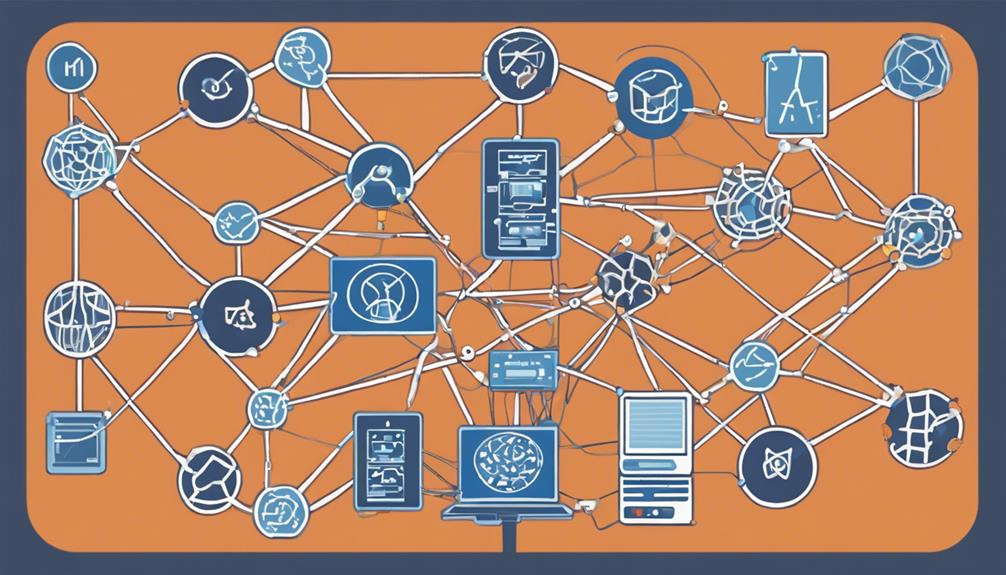Unlock the digital treasure trove of web data mining used in business to unearth valuable insights that can revolutionize your strategies. Dive into the realm where data whispers secrets of consumer behavior, market trends, and competitive landscapes. Discover how businesses leverage web data mining to navigate the complex maze of digital markets, predict future trends, and outmaneuver the competition. Explore the power of data-driven decision-making and the endless possibilities that await those who harness the potential of web data mining in driving business success.
Market Research
When conducting web data mining for market research, businesses gain valuable insights into consumer behavior and preferences. By analyzing online activities, businesses can conduct competitive analysis to understand how their products or services stack up against competitors. Web data mining allows for the collection and analysis of vast amounts of data, providing businesses with a comprehensive view of consumer behavior patterns and trends.
Through competitive analysis, businesses can identify strengths and weaknesses in their offerings compared to competitors, enabling them to make informed decisions to improve their market positioning. Additionally, by understanding consumer behavior through web data mining, businesses can tailor their marketing strategies to better target their audience and enhance customer engagement.
Customer Segmentation
As you explore the realm of customer segmentation, you uncover the power it holds for targeted marketing strategies. By dividing your customer base into distinct groups based on behaviors and preferences, you can tailor your marketing efforts to resonate more effectively with each segment. This precision opens up avenues for product personalization and enables you to analyze market trends with greater accuracy.
Targeted Marketing Strategies
Targeted marketing strategies, specifically customer segmentation, play a crucial role in optimizing business efforts to reach and engage with the right audience. By utilizing web data mining techniques, businesses can effectively identify and categorize customers based on their demographics, behaviors, and preferences. Customer targeting allows companies to tailor their marketing campaigns to specific segments, ensuring that the right message reaches the right people at the right time.
Campaign optimization is another key benefit of customer segmentation through web data mining. By analyzing customer data, businesses can fine-tune their marketing strategies to improve conversion rates and maximize ROI. Understanding the unique needs and characteristics of different customer segments enables companies to create personalized and relevant campaigns that resonate with their target audience.
Incorporating web data mining into targeted marketing strategies not only enhances customer engagement but also boosts overall marketing effectiveness. By leveraging data insights to segment customers and optimize campaigns, businesses can drive better results and achieve sustainable growth in today’s competitive digital landscape.
Product Personalization
Utilizing web data mining techniques enables businesses to enhance product personalization through effective customer segmentation. By analyzing user behavior patterns gathered from online interactions, businesses can create more personalized experiences for their customers. Through the use of recommendation engines, companies can tailor product recommendations based on individual preferences and past purchasing behavior.
Customer segmentation allows businesses to categorize customers into different groups based on similarities such as demographics, behavior, or preferences. This segmentation helps in understanding the diverse needs of customers and enables businesses to offer targeted products or services that resonate with each segment.
Recommendation engines play a vital role in product personalization by providing customers with tailored suggestions based on their browsing history, purchase patterns, and even feedback. These engines use algorithms to predict what products a customer is likely to be interested in, increasing the chances of a successful sale and enhancing overall customer satisfaction.
Market Trend Analysis
Enhancing market trend analysis through customer segmentation is a strategic approach for businesses looking to stay competitive in the ever-evolving digital landscape. By utilizing web data mining techniques, companies can gain valuable industry insights and understand consumer behavior more effectively. Through customer segmentation, businesses can categorize their target audience based on various parameters like demographics, browsing patterns, purchase history, and preferences.
This segmentation allows for personalized marketing strategies, product recommendations, and tailored communication approaches. By analyzing market trends within these segmented groups, businesses can adapt their strategies to meet specific customer needs and preferences, ultimately driving sales and enhancing customer satisfaction. Additionally, customer segmentation enables companies to identify emerging trends, anticipate shifts in consumer behavior, and stay ahead of the competition.
Risk Management
Effective risk management is crucial for businesses operating in today’s dynamic and competitive environment. Utilizing web data mining techniques such as data analysis, fraud detection, credit scoring, and market surveillance can greatly enhance a company’s risk management strategies. By analyzing large datasets from various online sources, businesses can identify patterns and anomalies that may indicate potential risks such as fraudulent activities or market fluctuations.
Data analysis plays a vital role in risk management by helping businesses uncover insights that can lead to better decision-making. Through advanced algorithms, companies can sift through vast amounts of data to detect irregularities that could pose risks to the organization. Additionally, employing fraud detection tools can aid in identifying suspicious activities, protecting the business from financial losses and reputational damage.
Credit scoring models built on web data mining can assist businesses in assessing the creditworthiness of customers, reducing the risk of defaults. Market surveillance tools can also provide real-time insights into market trends and fluctuations, allowing companies to proactively manage risks associated with changing market conditions. By leveraging web data mining for risk management, businesses can enhance their ability to anticipate and mitigate potential threats effectively.
Predictive Modeling
Predictive modeling in web data mining allows you to anticipate future trends and identify crucial patterns within your business data. By leveraging predictive algorithms, you can forecast market changes, customer preferences, and potential risks with greater accuracy. This strategic approach empowers you to make informed decisions and stay ahead of the competition.
Forecasting Future Trends
When looking to anticipate future trends in business, one crucial tool that stands out is predictive modeling. By utilizing historical data and advanced algorithms, predictive modeling plays a key role in forecasting future trends such as demand prediction and trend analysis. This powerful technique allows businesses to analyze patterns and behaviors to make informed decisions about potential outcomes.
Demand prediction is a critical aspect of forecasting future trends in business. By examining past sales data, consumer behavior, and market trends, predictive modeling can help businesses estimate future demand for products or services. This information is invaluable for optimizing inventory levels, pricing strategies, and overall business planning.
Trend analysis is another essential component of predictive modeling for forecasting future trends. By identifying patterns and correlations within large datasets, businesses can gain insights into emerging trends in their industry. This allows companies to adapt their strategies proactively, stay ahead of the competition, and capitalize on upcoming opportunities.
Identifying Key Patterns
Amidst the vast landscape of data available to businesses today, the process of identifying key patterns through predictive modeling emerges as a crucial endeavor. By leveraging tools such as anomaly detection and predictive analytics, businesses can uncover valuable insights from their data. Through behavioral analysis and pattern recognition, businesses can delve deep into consumer behavior, market trends, and operational efficiencies.
Anomaly detection plays a pivotal role in identifying irregularities within datasets, helping businesses pinpoint potential fraud, errors, or outliers that could impact decision-making processes. Predictive analytics, on the other hand, enables organizations to forecast future trends based on historical data, allowing for proactive decision-making and strategic planning.
Behavioral analysis allows businesses to understand customer preferences, buying habits, and sentiments towards products or services. By recognizing patterns in consumer behavior, businesses can tailor their marketing strategies to enhance customer engagement and drive sales. Pattern recognition further aids in identifying recurring trends or relationships within data sets, enabling businesses to make informed decisions and optimize their operations for success.
Sentiment Analysis
One effective way businesses harness the power of web data mining is through Sentiment Analysis. By analyzing social media content, businesses can gain valuable insights into public opinion and sentiment towards their brand. This process involves using advanced algorithms to classify opinions expressed in online posts, reviews, and comments as positive, negative, or neutral.
Through Sentiment Analysis, companies can monitor brand reputation in real-time, identifying potential issues or areas of improvement before they escalate. By understanding customer sentiment, businesses can tailor their marketing strategies, product development, and customer service efforts to better meet consumer needs and expectations.
Furthermore, Sentiment Analysis allows businesses to track trends and sentiments across different demographics, geographic locations, or time periods. This information can provide valuable guidance for decision-making processes and help companies stay ahead of the competition. Leveraging the insights gained from Sentiment Analysis can ultimately lead to enhanced customer satisfaction, increased brand loyalty, and improved overall performance in the market.
Competitive Intelligence
Analyzing your competitors’ strategies and performance can provide valuable insights for your business. By leveraging web data mining for competitive intelligence, you can stay ahead in the market. Here are some key ways this can benefit your business:
- Industry benchmarking: Compare your performance metrics with industry averages to identify areas for improvement and competitive advantages.
- Brand reputation: Monitor online sentiment towards your competitors to gauge customer perception and identify potential areas to enhance your own brand reputation.
- Competitor pricing: Analyze pricing strategies of competitors to adjust your pricing strategy accordingly and stay competitive in the market.
- Product trends: Track your competitors’ product launches and updates to anticipate market trends and adapt your offerings proactively.
Utilizing web data mining for competitive intelligence allows you to make informed decisions, identify new opportunities, and enhance your competitive edge in the business landscape.
Personalized Marketing
Harnessing the power of personalized marketing can revolutionize how you engage with your target audience. By utilizing behavioral targeting and customer profiling, you can tailor your marketing strategies to individual preferences and behaviors. Understanding your customers’ online activities and purchase history enables you to create personalized campaigns that resonate with their interests and needs.
User engagement is crucial in personalized marketing. By delivering relevant content based on data-driven insights, you can enhance user experience and drive conversions. Content personalization plays a key role in capturing the attention of your audience and fostering long-term relationships with customers.
Through web data mining, you can gather valuable information that allows you to segment your audience effectively and deliver targeted messages. Personalized marketing not only increases customer satisfaction but also boosts brand loyalty and ultimately drives revenue growth. Embracing personalized marketing strategies can set your business apart in a competitive marketplace and create meaningful connections with your customers.
Frequently Asked Questions
How Can Web Data Mining Improve Supply Chain Management?
To improve supply chain management, web data mining can enhance inventory optimization by analyzing historical data for accurate demand forecasting. Utilizing this technology, businesses can reduce excess inventory, minimize stockouts, and streamline operations effectively.
What Are the Ethical Considerations in Web Data Mining?
When considering ethical implications of web data mining, privacy concerns and data security are paramount. Protecting individuals’ personal information and ensuring data is handled responsibly should be top priorities to maintain trust and ethical standards.
Can Web Data Mining Help in Fraud Detection?
When it comes to fraud prevention, web data mining plays a crucial role. By analyzing patterns and anomalies in data, you can enhance risk analysis and detect fraudulent activities swiftly, ultimately safeguarding your business from potential financial losses.
How Does Web Data Mining Influence Pricing Strategies?
Analyzing web data through data mining can provide valuable insights into competitive pricing strategies based on customer behavior. By identifying trends and patterns, businesses can optimize prices, conduct thorough competitive analysis, and enhance their pricing strategies for better profitability.
What Impact Does Web Data Mining Have on Business Scalability?
As you explore web data mining’s impact on business scalability, you’ll find it crucial for growth. By analyzing customer behavior, preferences, and trends, businesses can enhance customer retention strategies, optimize operations, and scale efficiently.



